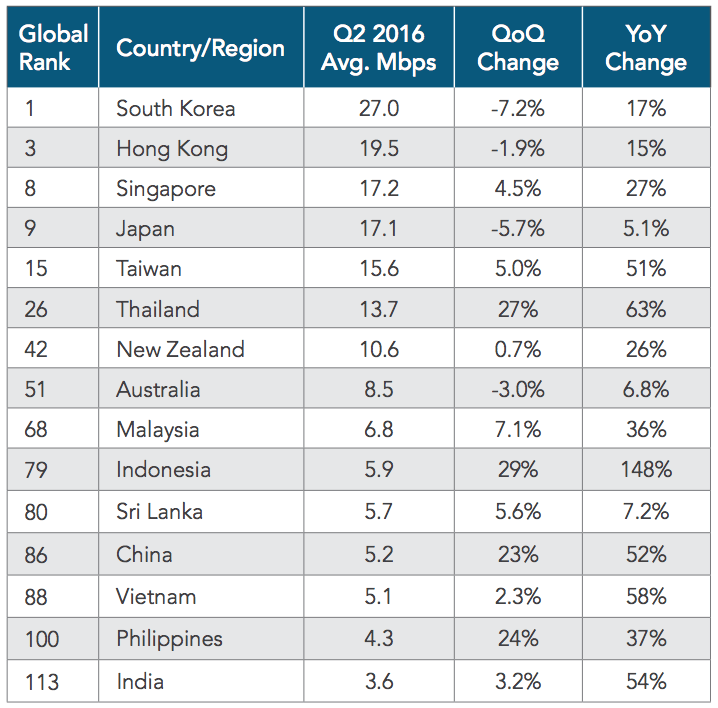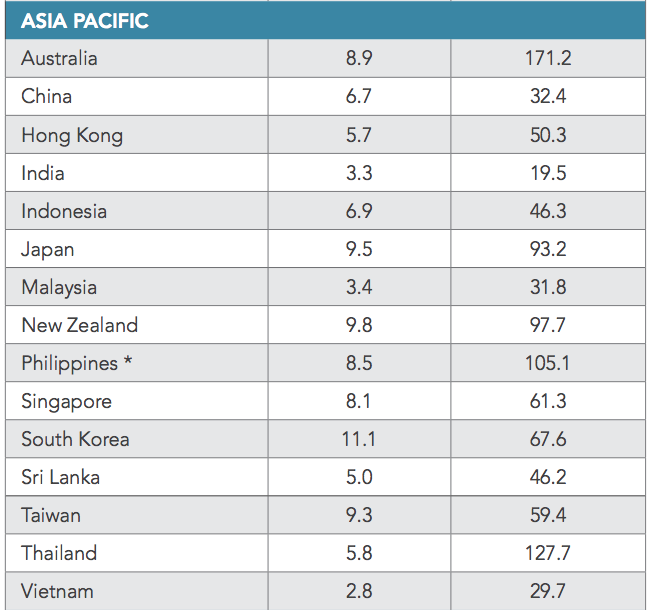(UPDATE, OCTOBER 7: We updated the Mobile-Internet Speed section in our article to counter another story claiming the Philippines’ average mobile-connection speed was faster than Singapore’s in the second quarter of 2016.)
According to the latest State of the Internet report of cloud-services provider Akamai, the Philippines moved one spot higher in the regional ranking, as it outpaced India in the broadband-connectivity race. In the first quarter of this year, it tied with the Southern Asian country for last place among 15 surveyed countries.
This time around, our average connection speed reached 4.3Mbps, up from 3.5Mbps in the previous quarter, while India’s remained under the 4Mbps broadband threshold.
South Korea was still king of internet speed, but Indonesia was again the only country in the region to have doubled its average connection speed.
The complete Asia Pacific ranking can be found below.

Asia Pacific internet-connection speeds ranking for Q2 2016, according to Akamai’s State of the Internet report
PH mobile internet faster than Singapore’s… not
For the first time, the Philippines was mentioned in the Mobile Connectivity section of Akamai’s latest State of the Internet report. If you look at the table farther below, the country posted an average mobile-connection speed of 8.5Mbps.
But — and this is a BIG BUT — including the Philippines when ranking all countries listed here and saying our average mobile-connection speed was faster than, say, Singapore’s last quarter, is not correct. Akamai only published that because the company made changes in this quarter’s report. We were not included in the analysis because we did not reach the minimum requirement of 25,000 unique IPv4 addresses seen by Akamai and classified as mobile during the quarter. This means the 8.5Mbps speed shown here may not be representative of the true average mobile connection of the Philippines.
The Philippines was not included in the analysis because it did not reach the minimum requirement of 25,000 unique IPv4 addresses seen by Akamai during the quarter. The 8.5Mbps speed may not be representative of the Philippines’ true average mobile connection.
According to Akamai: “Beginning with this quarter’s report, the countries/regions covered in this [Mobile Connectivity] section, along with their categorization, have been altered slightly to align with the rest of the State of the Internet report. This section will now provide mobile data and analysis for the same surveyed countries or regions covered in Sections 4 through 7 of this report.”
Hence the Philippine mention for the first time. And only a mention.

Center: average connection speed. Leftmost: average peak connection speed. Take note that the asterisk after ‘Philippines’ means fewer than 25,000 unique IPv4 addresses classified as mobile were observed in Q2 2016, so the country was not included in the ranking
MY THOUGHTS: I’m more than happy with the 50Mbps internet connection I have at home; so far, Globe Telecom is doing a great job of delivering the advertised speed of the fiber plan I’m subscribed to. But I know only a few households get to experience this. When the rest of the population gets a broadband-connection speed of just a little bit higher than that of the lowest-ranked country in the mobile-connectivity race, you know there’s something wrong with the picture. Local telcos and the government should step up efforts to bring the country out of the quagmire it’s in.
When the rest of the population gets a broadband-connection speed of just a little bit higher than that of the lowest-ranked country in the mobile-connectivity race, you know there’s something wrong with the picture.
MY PARTNER RAMON LOPEZ’S TAKE: The good news is, the Philippines is no longer dead last for downloads in APAC, perhaps partly because fiber connections are available in more areas than ever before. Bad news is — and this often gets lost in the discussion — there’s now a rather limiting hard cap on some subscriptions that offer faster speeds. Which is ironic when you consider many of these offers come with access to video-streaming sites that can eat up bandwidth fast. It’s as if local telecom companies want you to burn through your monthly allotment to get you to purchase more data. I think it’s only right to insist on higher standards from companies that provide us with internet access. Speed is a valuable metric, sure. But it’s no longer the only one that matters in today’s cloud-first, mobile-first world.
Video you may want to watch
World’s first 5G mobile device by BBC Click
Share this Post



